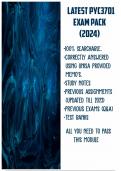Exam (elaborations)
PYC3701 Latest Exam Pack 2024
- Course
- Institution
- Book
Latest PYC3701 exam pack – This document will help you pass the module with ease. The document contains summary notes, previous exam/assignment questions, & answers.
[Show more]




